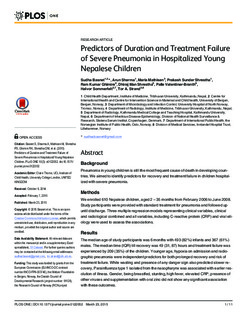Predictors of duration and treatment failure of severe pneumonia in hospitalized young nepalese children
Basnet, Sudha; Sharma, Arun; Mathisen, Maria; Shrestha, Prakash Sunder; Ghimire, Ram Kumar; Shrestha, Dhiraj Man; Valentiner-Branth, Palle; Sommerfelt, Halvor; Strand, Tor
Journal article
Permanent lenke
http://hdl.handle.net/11250/2384638Utgivelsesdato
2015Metadata
Vis full innførselSamlinger
- Artikler [5068]
- Publikasjoner fra CRIStin FHI [7544]
Sammendrag
BackgroundPneumonia in young children is still the most frequent cause of death in developing countries. We aimed to identify predictors for recovery and treatment failure in children hospitalized with severe pneumonia.
MethodsWe enrolled 610 Nepalese children, aged 2 – 35 months from February 2006 to June 2008. Study participants were provided with standard treatment for pneumonia and followed up until discharge. Three multiple regression models representing clinical variables, clinical and radiological combined and all variables, including C-reactive protein (CRP) and viral etiology were used to assess the associations.ResultsThe median age of study participants was 6 months with 493 (82%) infants and 367 (61%) males. The median time (IQR) till recovery was 49 (31, 87) hours and treatment failure was experienced by 209 (35%) of the children. Younger age, hypoxia on admission and radiographic pneumonia were independent predictors for both prolonged recovery and risk of treatment failure. While wasting and presence of any danger sign also predicted slower recovery, Parainfluenza type 1 isolated from the nasopharynx was associated with earlier resolution of illness. Gender, being breastfed, stunting, high fever, elevated CRP, presence of other viruses and supplementation with oral zinc did not show any significant association with these outcomes.ConclusionAge, hypoxia and consolidation on chest radiograph were significant predictors for time till recovery and treatment failure in children with severe pneumonia. While chest radiograph is not always needed, detection and treatment of hypoxia is a crucial step to guide the management of hospitalized children with pneumonia.
Beskrivelse
-
